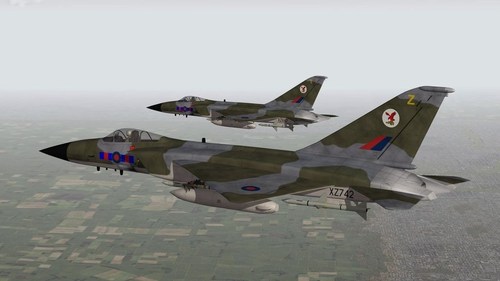Panavia Condor F.1 for STRIKE FIGHTERS 2
On July 25th 1968 a memorandum of understanding was signed by Belgium, Canada, Italy, the Netherlands, the UK and West Germany expressing their interest and intent on producing a multi-role combat aircraft (MRCA) with a tentative in-service date of 1975. Belgium dropped out very early and before the end of the year Canada had also pulled out with Prime Minister Pierre Trudeau claiming that they simply could not afford it but this was, perhaps, a convenient excuse to hide behind whilst Trudeau's liberal goverment re-shaped the entire Canadian armed forces. For a short while the remaining four nations ploughed on but the Dutch became increasingly concerned as their prime mission was for an air superiority fighter and even though they had cranked in severe requirements for long radius of action and maximum performance in air combat at all altitudes they then complained when the resultant design became larger and therefore more expensive. Once the Dutch had left the MRCA project the remaining three nations formed a Joint Working Group firming up on requirements, removing excessive demands and establishing a technically viable baseline solution to their MRCA requirement. Fashionably, this baseline solution was a swing-wing design with afterburing turbofan engines. With all three Governments on board the project was to be delivered by a co-ordinating organisation called NAMMO (NATO MRCA Management Organisation) employing three newly created international contractor companies; Panavia Aircraft GmbH (airframe), Turbo-Union Ltd (engines) and Avionica Systems Engineering GmbH (avionics) that would combine to produce the Panavia Tornado.
Whilst the RAF were fully behind the swing-wing MRCA design for their all-weather interdiction and strike requirements they expressed deep concern over it's suitability to meet their RAF Air Staff Requirement 395 which called for a long-range interceptor to replace the Lightning and Phantom. Influenced by U.S. studies on future air superiority fighter aircraft, and especially by John Boyd's energy–maneuverability theory, the RAF demanded an aircraft with extra power and maneuverability compared to the proposed Tornado ADV. Whilst they conceded that the Tornado ADV might be acceptable as a long-range interceptor it would be totally outclassed as a 'central front' fighter by the expected threats of the next generation of Soviet fighter aircraft (in particular, and before it's limitations became known, the MiG-25 was especially feared). When the UK Government argued that another combat aircraft could not be considered on cost grounds the RAF reminded them that the proposed Tornado ADV was already morphing into a different aircraft with a longer forward fuselage to accommodate semi-recessed Sparrow/Skyflash missiles, more powerful engines to address the low power to weight ratio and a totally different avionics package.
Panavia were already ahead of the curve with several design studies on various advanced air superiority fighter aircraft with the most promising being 'Projekt Condor' from the Messerschmitt-Bölkow-Blohm (MBB) design team at Ottobrun for a single-seat air superiority fighter powered by a single large afterburning turbofan engine (the RB.250 - itself a paper project by Turbo-Union but based on a scaled-up Rolls-Royce Spey turbofan). Preliminary technical studies demonstrated that Specific Excess Power and manoueverability were off the chart when compared to all current fighter aircraft and a parallel study on the market for such an aircraft in the 1975 to 1990 period revealed a potential market for 600 aircraft in Western Europe and the Middle East alone. Unexpected support for Projekt Condor came from the Italian Government who sought a follow-on fighter aircraft to replace the Aeritalia F-104S on the Turin production line. In the UK, with unemployment at its highest level since 1940, the incoming Conservative Government led by Edward Heath supported the project as one of a raft measures to boost the UK economy. By 1971 all three Governments (Italy, the UK and West Germany) were in agreement and the Panavia Condor programme was allowed to proceed with an initial order for 10 Condor prototype and development aircraft and 465 production aircraft (West Germany 200, UK 165 and Italy 100) to be assembled on final production lines in each country but with workload shared out with the United Kingdom and West Germany each having a 40% share of the workload with the remaining 20% going to Italy.
With inflation running rampant in Western Europe the Condor programme was under the strictest financial scrutiny during the early 1970's but luckily escaped the axe on at least two occassions. Despite the Condor programme being a political football (and seemingly a permanent fixture in the news headlines) development moved swiftly aided by the existing collaborative structures within Panavia recently created for the Tornado programme. With a new airframe and a new engine Panavia were keen to avoid also introducing a completely new avionics package so sensibly opted for an off-the-shelf purchase of the Hughes APG-63 multimode radar system but designed to incorporate a software programmable signal processor allowing the system to be modified to accommodate new modes and weapons through software reprogramming rather than by a more costly and disruptive hardware retrofit. The first prototype (PC-01) was structurally complete by early April 1974 and was trucked from Ottobrun to the Hannover Air Show where it was displayed in the static park attracting considerable interest from Saudi Arabian and Omani officials. DA-01 was then taken to Manching to be mated with the Turbo-Union RB.250 engine for ground-testing and taxying trials that continued during the summer months before MBB's chief test pilot, Nils Meister, took to the air on August 15th 1974. A few short weeks later he dazzled the crowds at the 1974 Farnborough Air Show demonstrating the Condor's remarkable manoueverability. The fleet of development aircraft began to build up during 1975 with the only real mishap occuring when DA-06 (whose main task was armament development) was mysteriously lost over the Irish Sea.
Entering service with No.23 Squadron of the Royal Air Force on April 1st, 1978 the Condor F.1 eventually served with seven squadrons in the UK and another two in RAF Germany. Primary armament was the Skyflash semi-active radar homing air-to-air missile and the AIM-9L 'all-aspect' version of the Sidewinder infra-red air-to-air missile. In addition, the Condor was fitted with two internal Mauser BK-27 cannon (developed for the Panavia Tornado) each with 250 rounds.
INSTRUCTIONS
1. From the AIRCRAFT folder drag and drop the CondorF1 folder into your Aircraft folder.
2. From the DECALS folder drag and drop the CondorF1 folder into your Decals folder.
3. From the GUNS folder drag and drop the BK-27 folder into your Guns folder (you might already have this).
CREDITS
Thanks to everyone at Cocas Aircraft Factory and especially to Nyghtfall (skins) and Spinners (decals & screens).
packing and original read me Spinners
Regards
Cocas
Version 1 - 05/05/2020
 5
5



